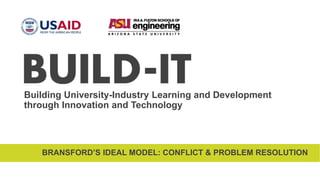
PL1 - IDEAL Model
- 1. Building University-Industry Learning and Development through Innovation and Technology BRANSFORD’S IDEAL MODEL: CONFLICT & PROBLEM RESOLUTION
- 2. A MODEL FOR PROBLEM RESOLUTION Identify the problem Define the problem Explore possible solutions for the problem Apply solutions to the problem Look at and learn from the effects of the solution * Model developed by John Bransford in the 1980’s I D E A L
- 3. IDENTIFY THE PROBLEM A problem can be identified through these different scenarios: 1. The difference between what is observed and what is expected. 2. The discrepancy between what we want and what we get. - Deno (2010)
- 4. IDENTIFY THE PROBLEM “Conflict arises from differences, both large and small. It occurs whenever people disagree over their values, motivations, perceptions, ideas, or desires. Sometimes these differences appear trivial, but when a conflict triggers strong feelings, a deep personal need is often at the core of the problem. These needs can be a need to feel safe and secure, a need to feel respected and valued, or a need for greater closeness and intimacy.” - Seagal and Smith (2016)
- 5. DEFINING THE PROBLEM Try to accurately determine the cause of the problem. Look at this problem through various lenses to try and understand the problem at its core. Is this a personal or professional problem? Are you concerned about money, feelings, respect, health, et cetera? Are you being honest with yourself and others? Once you understand your problem better, you should begin to understand yourself better as well. Photo by Kevin Labianco
- 6. EXPLORE POSSIBLE SOLUTIONS • This will be the most time-consuming step in the process. • As scientists, you know that gathering information can be tedious. • Take time to consult with family, friends, colleagues, or someone who can help you explore possible solutions in an unbiased manner. • Once you feel like you have gathered enough information and have spoken with the right people, now you can attempt to apply your solution(s) to the problem.
- 7. APPLY SOLUTIONS TO THE PROBLEM Problems very rarely resolve themselves. We need to take action and apply the solutions to the problem. • The first solution you attempt may not resolve the problem. • Think about a student who wants to improve his/her grade at the end of the semester. What solutions could the student use to solve this problem? Complaining Siting unfairness in the grading system Shifting blame to the professor Appealing to emotion Asking for a second chance on an exam Asking for the opportunity to complete ”extra credit” work Filing a grievance with the dean While many of these “solutions” won’t get the students what they want, they are testing different solutions to resolve their problem.
- 8. LOOK AT AND LEARN FROM THE EFFECTS OF THE SOLUTION The last step in this process is where you get to analyze the effectiveness of your solution. Were you successful or does your solution need revision? Are all parties satisfied with the resolution? You may notice that this process can take a bit of time. However, the more you use this process, the more efficient it should become in your life. Sometimes, you may need to “tweak” your process a bit to adapt to the problem you are currently handling. Learn from the both the process and your mistakes.
- 9. ACTIVITY Please print the worksheet that related to this lesson and bring it to the face-to-face session. You will be using this process as you plan your mini-project.
- 10. REFERENCES • Bransford, J. & Stein, B. (1984). The IDEAL Problem Solver: A guide for improving thinking, learning, and creativity. New Youk: W.H. Freeman. • Deno, Stan. (2010). The Problem Solving Model: An Interview with Dr. Stan Deno. Research Institute for Problem Solving. The University of Minnesota. • Deno, S.L. (2005). Problem Solving Assessment. In R. Brown-Chidsey (Ed.)., Assessment for intervention: A problem solving approach (pp. 10-42). New York: Guilford Press. • Segal, J. & Smith, M. (2016). Conflict Resolution Skills. Helpguide.org.